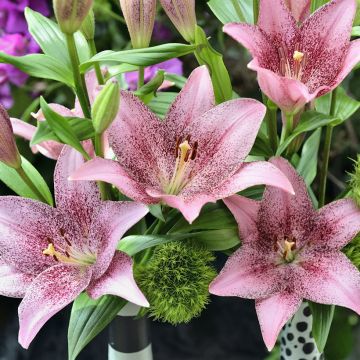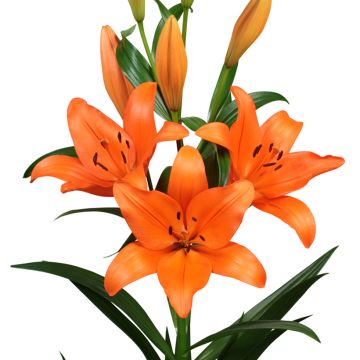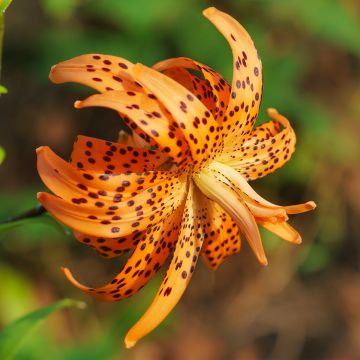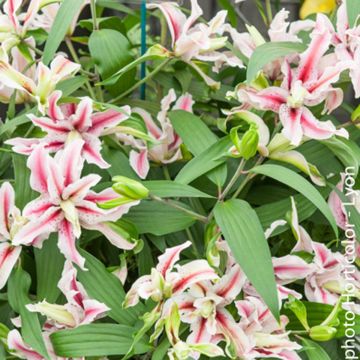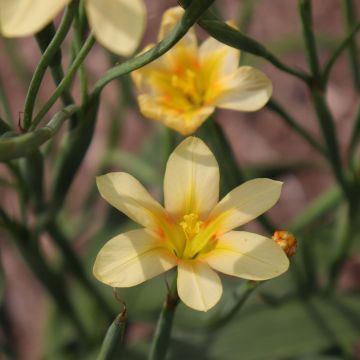

Lilium Orfeo® - Lily
Lilium Orfeo® - Lily
Lilium Orfeo®
Lily, Asiatic Lily, Oriental Lily, Turk's Cap Lily
This item cannot be shipped to the selected country
Delivery charge from €5.90
More information
Schedule delivery date,
and select date in basket
This plant carries a 6 months recovery warranty
More information
We guarantee the quality of our plants for a full growing cycle, and will replace at our expense any plant that fails to recover under normal climatic and planting conditions.
From €5.90 for pickup delivery and €6.90 for home delivery
Express home delivery from €8.90.
Does this plant fit my garden?
Set up your Plantfit profile →
Description
The Orfeo Lily displays a dramatic colouring: a deep dark red leaning towards purple, enhanced by the satiny texture of the flowers. Its tall yet sturdy stems bear several floral buds that bloom between July and August. Easy to grow, faithfully reblooming over the years, this very beautiful lily only lacks fragrance. It is a very beautiful bulbous plant for borders, also stunning in pots and perfect for cut flowers.
The Lilium genus has given its name to the lily family. Horticultural lilies are classified into several major categories based on their botanical characteristics and the cross-breeding they originate from. The Lilium 'Orfeo' belongs to the TA hybrids (Trumpet x Asiatic), robust and colourful, non-fragrant, with flowers erecting upwards.
The Orfeo Lily is a deciduous bulbous plant whose vegetation emerges in spring and disappears in winter. This cultivar has a narrow and very vertical habit, reaching 1m to 1.20m in height when flowering under the right growing conditions. The clump will spread indefinitely over time, with bulbs producing bulblets through vegetative propagation. This variety blooms between July and August, depending on the climate. Five to nine flowers bloom along the stems, each measuring up to 15cm in diameter. The stamens are covered in a very dark pollen, complementing the harmony of colours. The stems are very sturdy, covered in alternate, narrow, shiny medium green leaves. Asiatic hybrids are the hardiest and easiest lilies to grow, known for their wide range of colours and abundant, albeit non-fragrant, flowering.
To create a border resembling a large bouquet with the Hybrid Lily 'Orfeo', opt for plants with generous, colourful blooms that will enhance its large red flowers. Pair it with Dahlia ‘Arabian Night’, with deep velvety red flowers, Echinacea purpurea ‘Magnus’ with large purple-pink flowers. Add a touch of light and fragrance with Paniculate Phlox ‘David’. The Agastache ‘Blue Fortune’, with its upright lavender spikes, will perfectly complement the colour harmony. Together, these plants create a colourful and abundant display, resembling a living bouquet throughout the summer.
Report an error about the product description
Plant habit
Flowering
Foliage
Botanical data
Lilium
Orfeo®
Liliaceae
Lily, Asiatic Lily, Oriental Lily, Turk's Cap Lily
Cultivar or hybrid
Other Hybrid Lilies
Planting and care
The 'Orfeo' lily appreciates humus-bearing, well-drained, and light soils. You will plant it in full sun, preferably in spring, burying the bulbs 15 cm deep in a pocket of soil mixed with leaf compost. Surround them with a pocket of sand to prevent rot and slug attacks while allowing them to grow more easily. Mark the planting location, as the vegetation only starts in April. When the stems reach 30 cm in height, discreetly stake them.
If red insects appear, treat them immediately; they are lily beetles whose larvae can devour all the leaves. The most effective method is to catch them by hand; be careful, they drop as soon as they are touched, so put a box underneath.
After flowering, it is useful to cut the faded flowers halfway so that the bed remains beautiful during the summer.
Tip for planting lilies in compact soil: The scaly bulbs of tall lilies fear clayey soils that suffocate them and cause rot. In Eastern Europe, the following technique is used to help these bulbs survive the winter. Plant them on 'benches' built above ground level. These benches consist of a first layer of gravel, on which tightly packed branches are placed. Cover everything with a thick layer of compost 20 to 30 cm deep. Plant the bulbs in the compost, on which you can also let some creeping plants grow.
On the terrace, you can create sumptuous pots with lilies. Choose a container that is wide and deep enough (at least 16 cm in diameter for 1 bulb). Fill it with a mix of garden soil, leaf compost, and sand. Plant the lilies in groups of 3 to 5 bulbs, 10-15 cm apart, then water generously. Place the pots in a cool room, or outside once the frosts have passed. The ambient temperature should be around 12°C. When the shoots appear, move the pot to a bright conservatory or room at around 18°C. Apply liquid fertilizer twice a month until the flower buds appear.
Planting period
Intended location
Care
This item has not been reviewed yet - be the first to leave a review about it.
Bulbs to grow in pots
Haven't found what you were looking for?
Hardiness is the lowest winter temperature a plant can endure without suffering serious damage or even dying. However, hardiness is affected by location (a sheltered area, such as a patio), protection (winter cover) and soil type (hardiness is improved by well-drained soil).

Photo Sharing Terms & Conditions
In order to encourage gardeners to interact and share their experiences, Promesse de fleurs offers various media enabling content to be uploaded onto its Site - in particular via the ‘Photo sharing’ module.
The User agrees to refrain from:
- Posting any content that is illegal, prejudicial, insulting, racist, inciteful to hatred, revisionist, contrary to public decency, that infringes on privacy or on the privacy rights of third parties, in particular the publicity rights of persons and goods, intellectual property rights, or the right to privacy.
- Submitting content on behalf of a third party;
- Impersonate the identity of a third party and/or publish any personal information about a third party;
In general, the User undertakes to refrain from any unethical behaviour.
All Content (in particular text, comments, files, images, photos, videos, creative works, etc.), which may be subject to property or intellectual property rights, image or other private rights, shall remain the property of the User, subject to the limited rights granted by the terms of the licence granted by Promesse de fleurs as stated below. Users are at liberty to publish or not to publish such Content on the Site, notably via the ‘Photo Sharing’ facility, and accept that this Content shall be made public and freely accessible, notably on the Internet.
Users further acknowledge, undertake to have ,and guarantee that they hold all necessary rights and permissions to publish such material on the Site, in particular with regard to the legislation in force pertaining to any privacy, property, intellectual property, image, or contractual rights, or rights of any other nature. By publishing such Content on the Site, Users acknowledge accepting full liability as publishers of the Content within the meaning of the law, and grant Promesse de fleurs, free of charge, an inclusive, worldwide licence for the said Content for the entire duration of its publication, including all reproduction, representation, up/downloading, displaying, performing, transmission, and storage rights.
Users also grant permission for their name to be linked to the Content and accept that this link may not always be made available.
By engaging in posting material, Users consent to their Content becoming automatically accessible on the Internet, in particular on other sites and/or blogs and/or web pages of the Promesse de fleurs site, including in particular social pages and the Promesse de fleurs catalogue.
Users may secure the removal of entrusted content free of charge by issuing a simple request via our contact form.
The flowering period indicated on our website applies to countries and regions located in USDA zone 8 (France, the United Kingdom, Ireland, the Netherlands, etc.)
It will vary according to where you live:
- In zones 9 to 10 (Italy, Spain, Greece, etc.), flowering will occur about 2 to 4 weeks earlier.
- In zones 6 to 7 (Germany, Poland, Slovenia, and lower mountainous regions), flowering will be delayed by 2 to 3 weeks.
- In zone 5 (Central Europe, Scandinavia), blooming will be delayed by 3 to 5 weeks.
In temperate climates, pruning of spring-flowering shrubs (forsythia, spireas, etc.) should be done just after flowering.
Pruning of summer-flowering shrubs (Indian Lilac, Perovskia, etc.) can be done in winter or spring.
In cold regions as well as with frost-sensitive plants, avoid pruning too early when severe frosts may still occur.
The planting period indicated on our website applies to countries and regions located in USDA zone 8 (France, United Kingdom, Ireland, Netherlands).
It will vary according to where you live:
- In Mediterranean zones (Marseille, Madrid, Milan, etc.), autumn and winter are the best planting periods.
- In continental zones (Strasbourg, Munich, Vienna, etc.), delay planting by 2 to 3 weeks in spring and bring it forward by 2 to 4 weeks in autumn.
- In mountainous regions (the Alps, Pyrenees, Carpathians, etc.), it is best to plant in late spring (May-June) or late summer (August-September).
The harvesting period indicated on our website applies to countries and regions in USDA zone 8 (France, England, Ireland, the Netherlands).
In colder areas (Scandinavia, Poland, Austria...) fruit and vegetable harvests are likely to be delayed by 3-4 weeks.
In warmer areas (Italy, Spain, Greece, etc.), harvesting will probably take place earlier, depending on weather conditions.
The sowing periods indicated on our website apply to countries and regions within USDA Zone 8 (France, UK, Ireland, Netherlands).
In colder areas (Scandinavia, Poland, Austria...), delay any outdoor sowing by 3-4 weeks, or sow under glass.
In warmer climes (Italy, Spain, Greece, etc.), bring outdoor sowing forward by a few weeks.

































